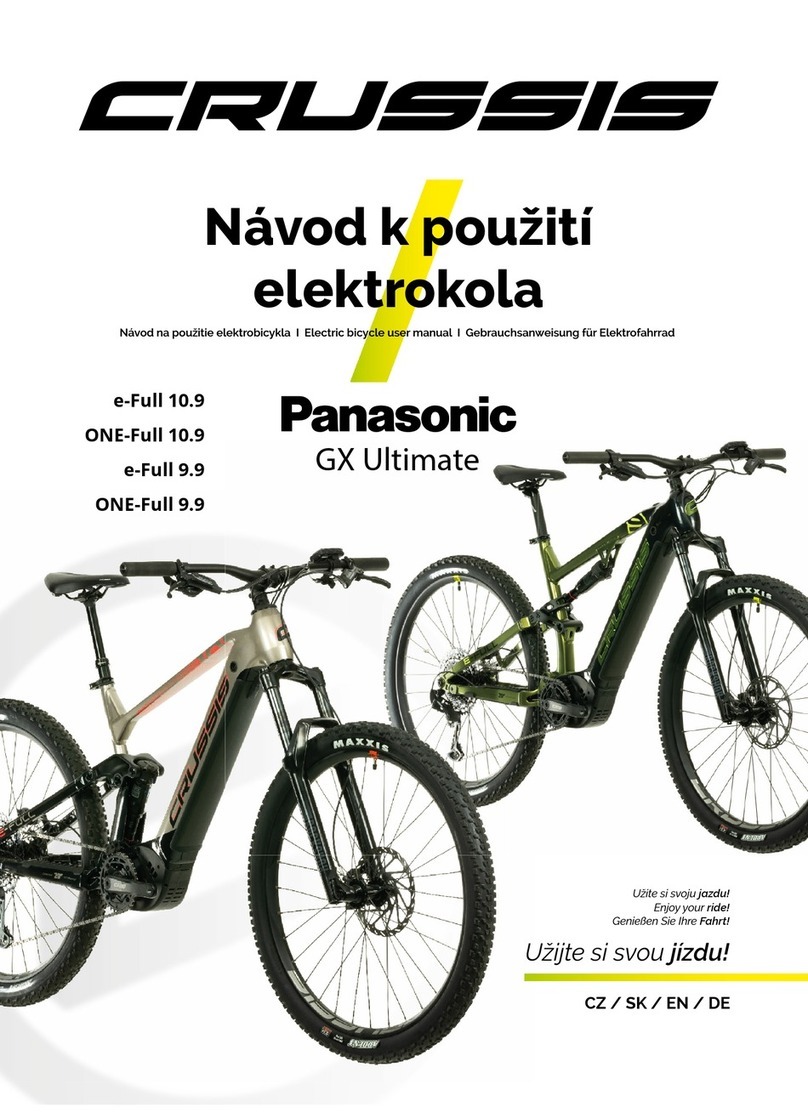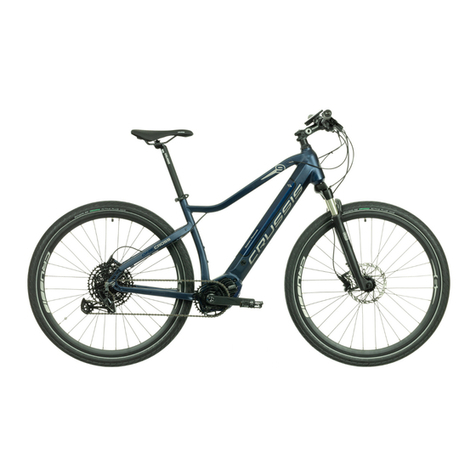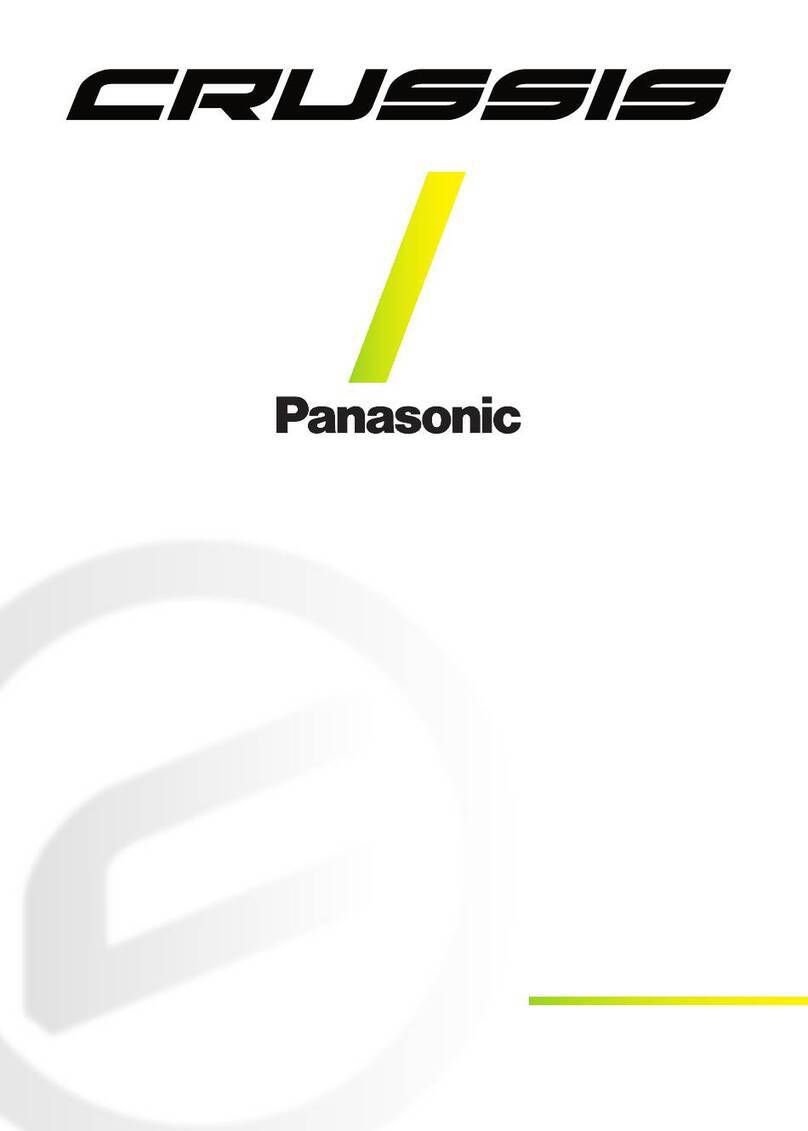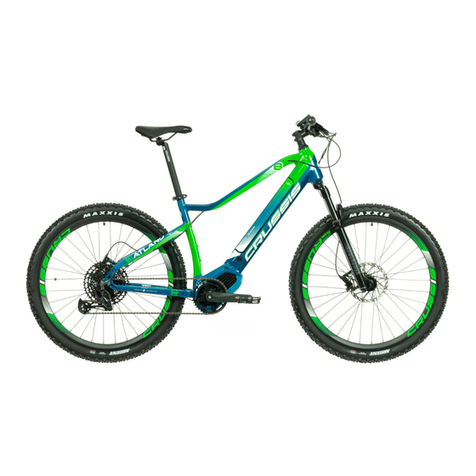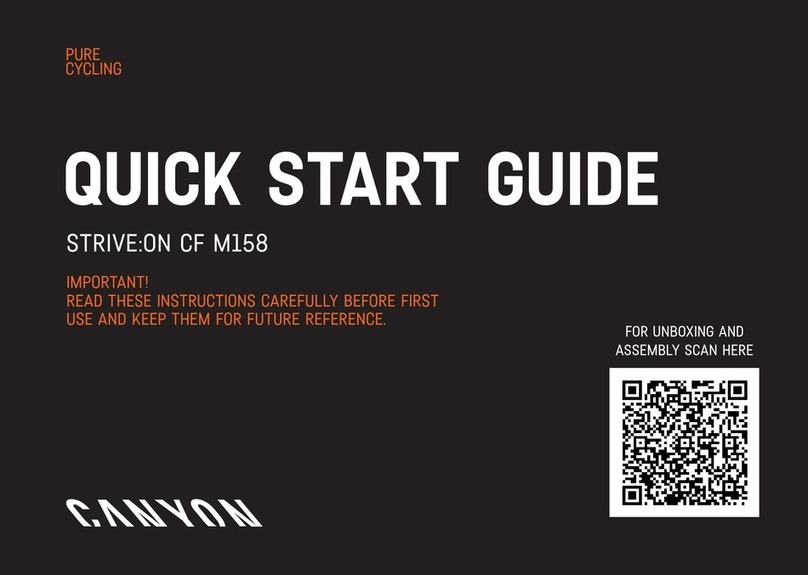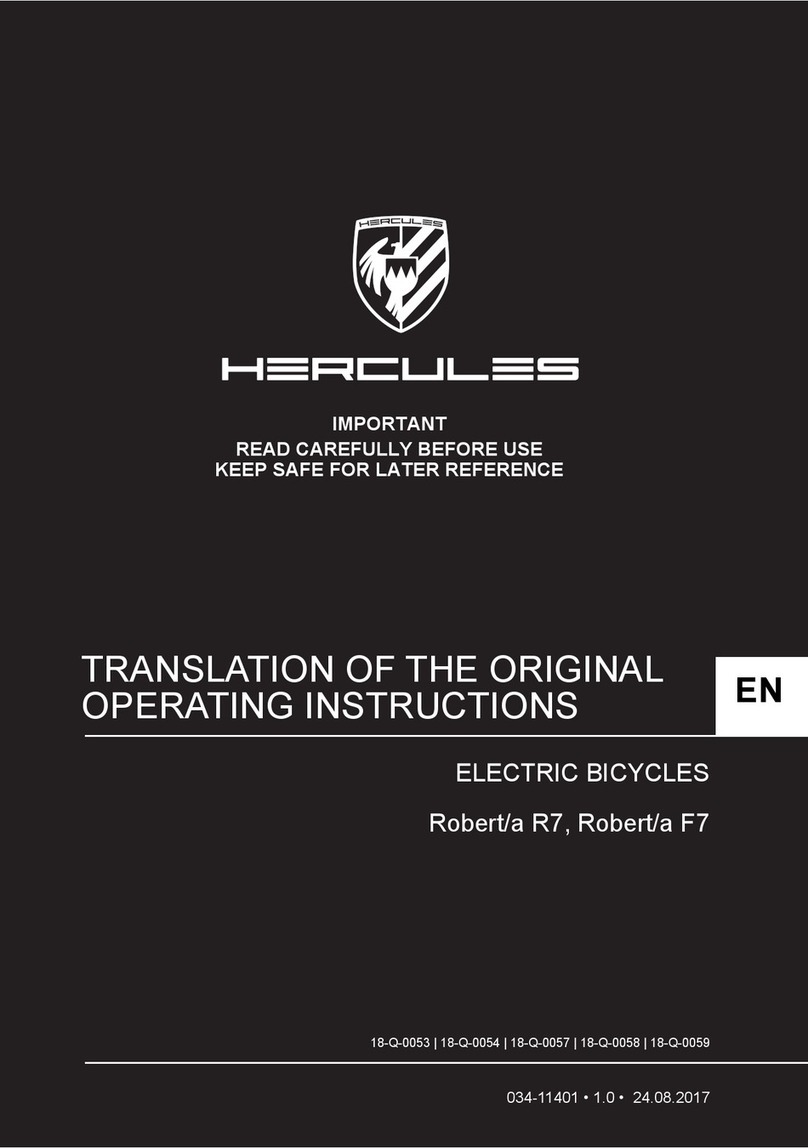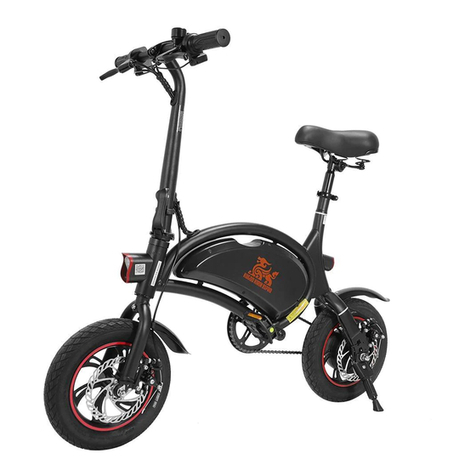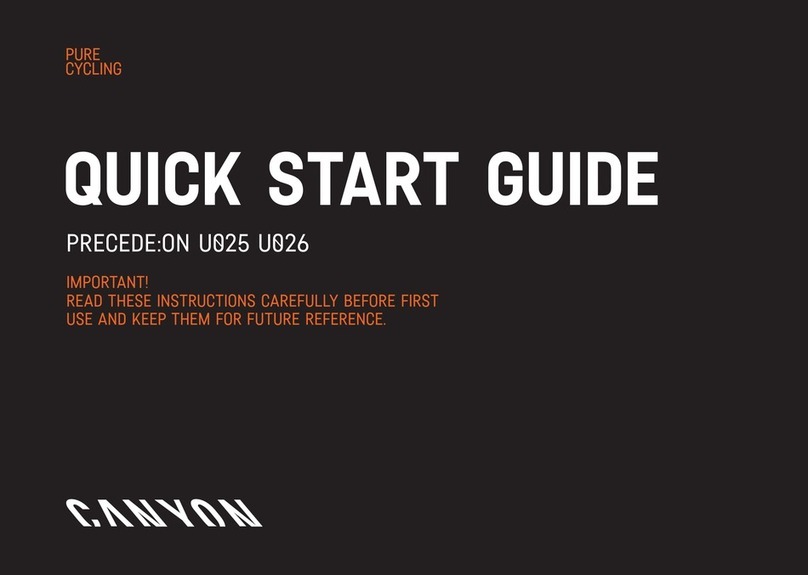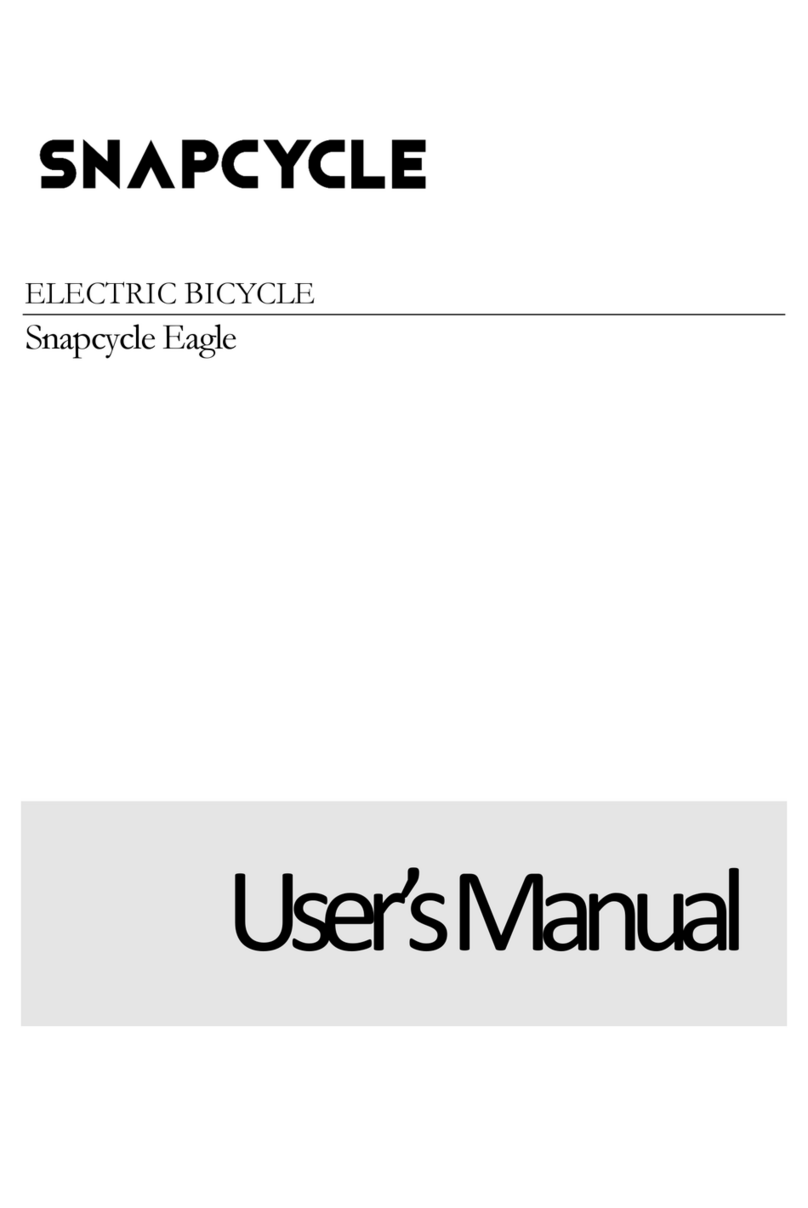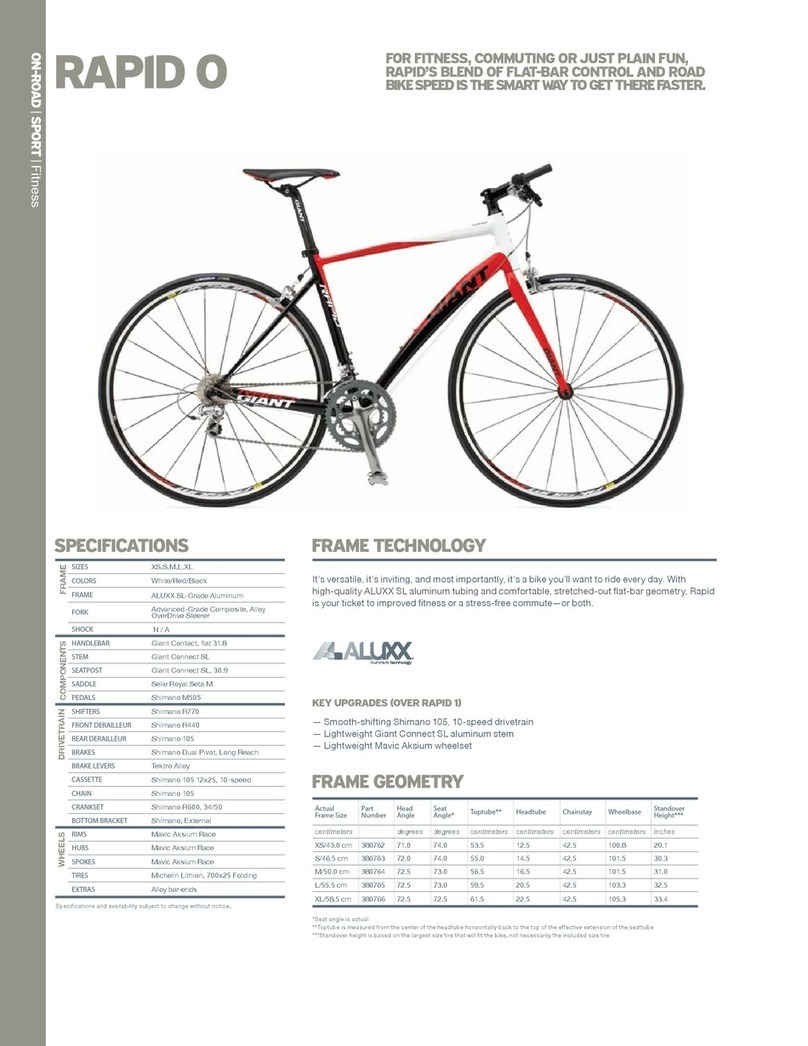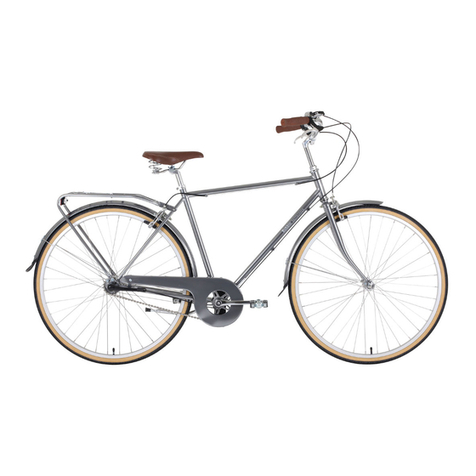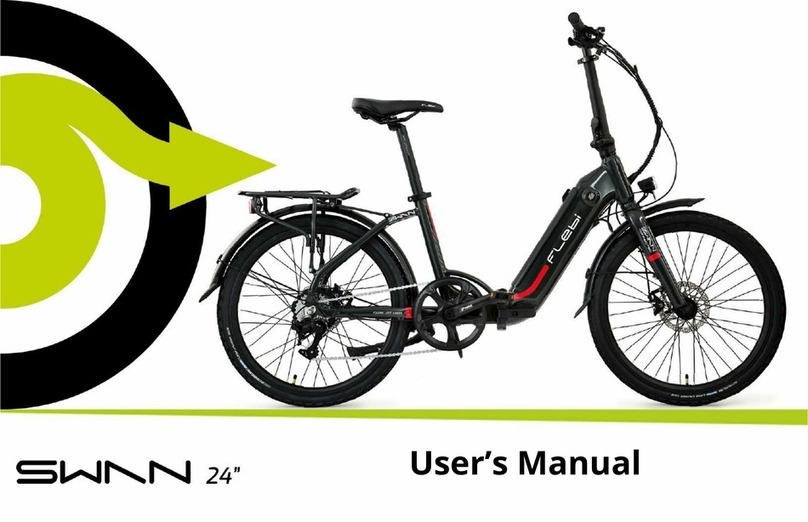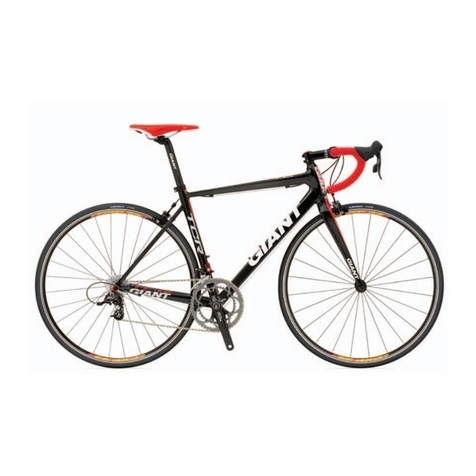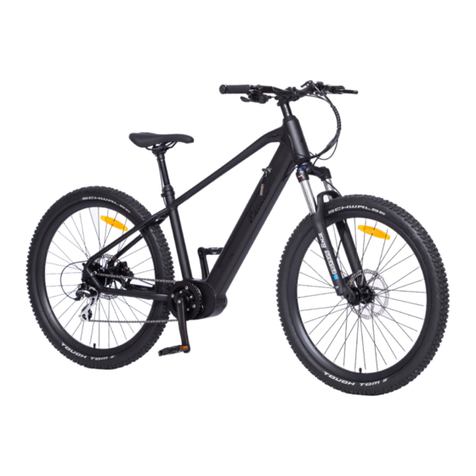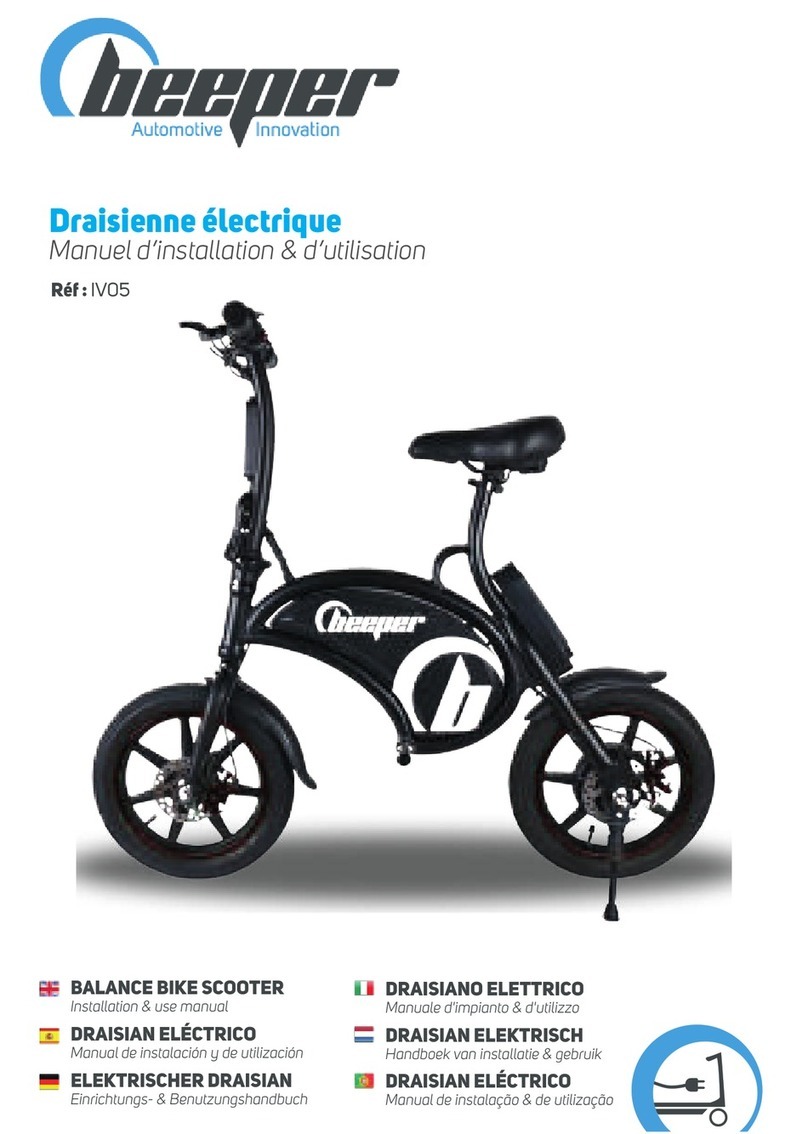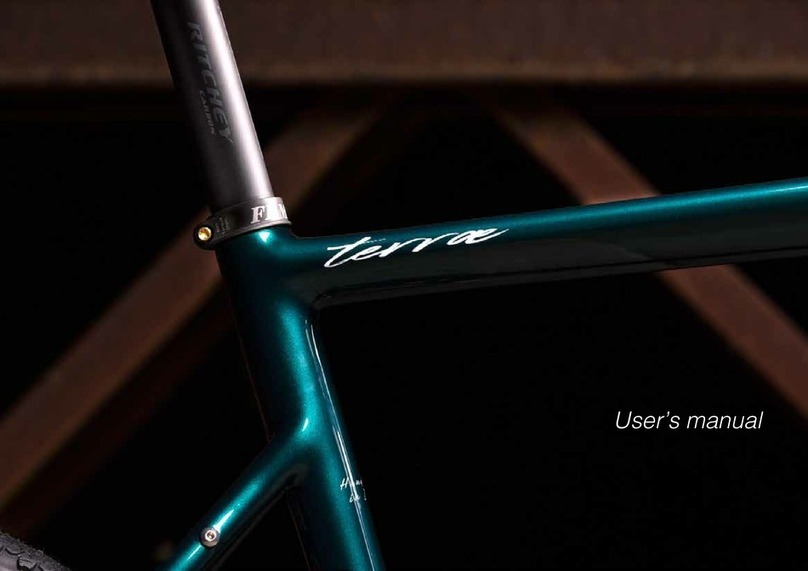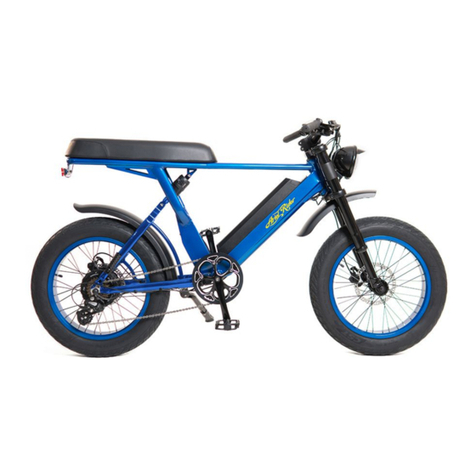CRUSSIS e-City 1.13 User manual

USER MANUAL FOR E-BIKES
e-City 1.13 / 1.13-S
e-City 1.14 / 1.14-S
e-City 2.6
e-Country 1.10 / 1.10-S

2
WHAT IS E-BIKE?
It is bike equipped with electromotor. Motor can be placed in the middle, rear or front hub. Motor can
have output up to 250 W. Maximum speed is limited to 25 km/h (after reaching max.speed the motor
will turn off and will turn on after the speed is lower than 25 km/h). In addition the bike is equipped with
battery that can be integrated in frame or placed on rear rack. The most important parameters of the
battery are voltage and capacity.The higher the values are, the longer is the distance range. Currently,
the most used batteries are lithium ion (Li-ion). The advantages of these batteries are mainly low
weight and long life. It is important to regularly charge the battery to extend battery life.
Communication between the individual electrical components is provided by a control unit, which
evaluates the data from the individual sensors, according to which it controls the power of the electric
motor. The operation of the electric motor is ensured by the control panel with information on battery
status, support level and remaining range. Most displays show the time, speed and distance traveled.
The motor function is activated by pedaling, which is detected by a special sensor located in the pedal
center. So you still have to pedal on the electric bike, the engine only helps you. The pedal sensor is
responsible for informing the control unit whether the rider has started or stopped pedaling and informs
about the pedaling frequency. The sensor is either magnetic sensor or a torsion sensor. Magnetic
sensor is a basic sensor, which works on the magnetic principle. This sensor, which is installed on the
center axis, monitors pedaling frequency. Activation of the sensor by peddaling back is impossible due
to the phasing of the magnets. Torsion sensors are used on more expensive sports bikes. In contrast
to magnetic sensors, they inform both about pedaling frequency and the force exerted on the pedal.
The torsion sensor is ideal for off-road riding, when there are frequent changes in the pedaling
frequency. If we need to pedal with more force, the engine gives us will immediately help with greater
performance. On the other hand, when driving downhill, when there is less pressure on the pedal, the
motor function is limited, thus saving battery power.
You can move the E-bike with button, but only to maximum speed of 6km/h (e.g walking
assistance).
The electric bicycle, which with its properties corresponds to the European standard EN 15194-1, is in
terms of law on road traffic is seen as a normal bicycle. That is, you can ride on on cycle paths, you do
not need a driver's license and a helmet is only mandatory until the age of 18. We still recommend to
use helmet regarding the age. (Every state has different law regarding e-bikes, always ask about your
local laws and ragulations).

3
COMPONENTS
1.
Battery
7.
Brakes
2.
Motor
8.
Gear change
3.
LED control panel
9.
Cranks
4.
Magnetic sensor
10.
Wheel quick release-lever
5.
Brake levers with engine disconnector
11.
Derailleur
6.
Battery lock
12.
Tire and rim
GENERAL WARNINGS
Riding an e-bike, like other sports, can carry a risk of injury and damage. If if you want to use an e-
bike, you must get acquainted with and follow the rules of safe riding on an e-bike, proper use and
maintenance of the e-bike. Regular maintenance and proper use will reduce the risk of injury and
extend the life of the product.
E-City 1.13 / 1.13-S, e-City 1.14 / 1.14-S, e-City 2.6 and Country 1.10 / 1.10-S e-bike models are
suitable for riding on paved roads, cycle paths, gravel and forest roads. The e-bike can be used as a
classic bicycle without the assistance of an electric motor.
Before you ride for the first time, check:
Correct e-bike size: Improperly selected wheel size can affect the maneuverability of the e-bike.
Seat height adjustment: The correct seat height affects the ride and handling comfortably.
Note: The groove indicates the maximum height for pulling out the seat tube. Never adjust the seat
tube above this height! This will prevent damage to the e-bike or seat tube and possible injury. The
correct position of the saddle is usually indicated by a scale on skids. Set the correct height of the
stem and handlebars.

4
Regular inspection:
Before each ride, regularly check the condition of your e-bike. In this way, many technical problems
can be avoided in time. The consequences of irregular inspections can be in many cases catastrophic.
The service life of the frame or components is affected by the construction and material used, as well
as the maintenance and intensity of use. Regular inspections should be done by qualified
professionals. Raise the e-bike to a height of 5 - 10 cm above the ground and release. By doing so
make sure everything is tightened enough. Then perform a visual and tactile inspection of the entire e-
bike. Above all, check the correct tightening of all bolts, nuts, pedal center, pedals, etc.
Wheels and tires: Check that the tires are properly inflated. Riding underinflated or vice versa over-
inflated tire can lead to poor bike handling. We recommend following the maximum and the minimum
pressure values specified by the manufacturer on the tire. Check tires for wear and proper shape. If
bumps or cracks appear on the tires, the tires must be replaced before use. Then check by turning the
wheels that the wheels are correctly centered and spokes are not loose or missing. Make sure, that
front and rear wheel are properly secured (Pic. 1, 2).
Brakes: Check the function of the brakes. Press both brake levers and push the wheel forward. The
brake pads must be in contact with rim (pic. 3). If not, it is necessary adjust the brakes. Check that the
cables are not frayed. Brake cables, brake pads and rims wear out with use, so it is necessary to
adjust the brakes regularly and worn parts exchange in time.
Gear shifter and chain: The chain requires regular maintenance to extend its lifespan. Before
lubrication, it is recommended to clean the chain and sprockets. Lubricate the chain with the tools
provided. The chain stretěch during use. The endurance of the chain is very individual and is
depended on the quality of the chain, the mileage, the riding style and the terrain in which you ride.
Regular chain replacement is necessary. It is possible check chain condition with a special gauge.
Pulled out or damaged chain can damage chain wheel and pinions. When riding, select gears so that
there was as little crossing of the chain as possible (pic. 4), e.g for smaller gears on the converter,
choose larger wheels for rear pinions (lighter gears), on the other hand for larger gears on the
converter choose smaller ones pinion wheels (heavier gears). During gear change, the cable is worn
and stretched. The gear change needs to be adjusted regularly to change gears correctly.

5
Fork: Regular maintenance is important to maintain proper fork function. Before each ride: If you find
any cracks, wedges, abrasions, deformations, oil leaks on the fork or other components, contact a
qualified mechanic to inspect the fork or wheel. Check the attachment of the wheels and the routing of
the cables and bowden cables - they must not restrict the movement of the handlebars in any way.
After each ride: Clean the dirt. Do not use high pressure cleaners –the water can get through the
duster into the fork. Lubricate the dust seals and fork legs. For lubrication do not use oil that is not
intended for forks. Consult your dealer for the use of a suitable oil.
Every 20 hours of use: Check the correct torque for the fork holders and other components. Cleaning
/ inspection and oil bath (replenishment / replacement if necessary).
Every 100 hours of use: Complete cleaning of the fork inside and out, cleaning and lubrication of
dust caps and cleaning rings, oil change in the damping system, tightening check.
Note that the fork is not designed for riding in extremely difficult terrain, for
jumps, downhill, freeride and or dirt jumps. Failure to respect this information
may lead to fork damage, accident or death. Failure to respect this information
will result in voiding the warranty. We do not recommend using oils on forks with
plastic sleeves containing teflon, there is a risk of etching the case.
Frame: Replace bent or cracked frame immediately. Under no circumstances should you attempt to
straighten or repair the frame yourself. Damaged frame consult with your supplier.
Always keep all components clean. If you wash the e-bike with water, never t
use high-pressure cleaners to clean the individual parts of the bike. Before
washing remove the battery from the bike. Dry the bike before returning the
battery. We recommend to dry out all parts after ride, especially all electrical
components. In winter, pay special attention to the maintenance of the e-bike,
always clean the components from salt and moisture after riding. Perform bike
maintenance at regular intervals. You can find information on the
recommended pressure directly on the side of the tire!
ELECTRIC BIKE SYSTEM
The motor is activated by means of a PAS sensor located at the pedal center. The engine of the e-bike
switches on after approx. one turn of the pedal cranks. It switches off again after 1-2 sec. when the
pedaling stops. For e-bike models with mechanical brakes, the motor switches off automatically when
the brakes are pressed. Hydraulic disc brakes are not equipped with brake disconnectors that disable
the engine. The engine switches off when it reaches a speed of 25 km/h and is reactivated if the travel
speed falls below this limit. This complies with all European standards and is still a bicycle. The e-bike
is equipped with an LCD panel that controls the electric drive. Various assistance modes can be
selected on the display (controller) 0 - 5. Highest assistance mode 5, assistance mode 0 is without the
help of an electric motor. LCD panel contains the "walking assistant" function as well. In this mode, the
bike moves at a speed of 6 km/h without pedal assistance. The walking assistant helps with pushing or
starting the bike. The function is not intended for permanent riding help.
Without motor assistance
Low motor assistance
Medium motor assistance
High motor assistance

6
Do not use modes 4-5 in extreme and long inclines, a combination of high loads
and low speeds can lead to overheating and damage to the engine. Engine
assistance modes are graduated, e.g., level 1 (lowest assistance) helps up to a
speed of approx. 12 km/h - level 5 (highest assistance) helps up to a speed of 25
km/h. Walking assistant: the bike rides without help at a speed of 6 km/h and
helps during pushing or starting. This function is not intended for use during
riding!
BATTERY INFORMATION
Currently, the most used batteries are lithium ion (Li-ion). The advantage of these batteries is mainly in
low weight and long lifespan. Li-ion batteries have a very low self-discharge. From the first charge, it is
necessary to keep the battery constantly in its working cycle (discharging / charging), even when the
battery is not used, it discharges, which is natural. We recommend to regularly recharge the battery
even if the e-bike is not used about once a month and store charged for 60 - 80% capacity. Failure to
do so may damage the battery, which may result in a shorter range or, in the worst case, complete
malfunction. Regular recharging extends battery lifespan. We recommend that you fully charge the
battery before using it for the first time. Because the battery does not have memory they can be
recharged at any time. The battery reaches its maximum capacity after approx. 5-10 charges. Keep
the battery charged and always charge after riding, not before the next ride. Li-Ion batteries are 100%
recyclable. You can return the battery to any collection point or directly to the dealer. Battery lifespan
is around 600 - 800 charging cycles, depending on the use. In practice, this means that you will need
to replace the battery after about 5 - 6 years of use. The battery is charged with the included charger
230 / 240V, charging time is about 5 - 9 hours (depending on the battery capacity and discharge
status). When charging, the battery can remain on the e-bike or it can be removed. To remove the
battery, turn the key and remove the battery (see pictures).
Always switch off the e-bike before charging the battery! Store the battery in a dry
place at room temperature without direct sunlight. Never expose the battery to
temperatures below 10 ° C and extremely high temperatures for extended periods
of time temperatures above 40 ° C. The battery is the most expensive part of the e-
bike. Pay attention to its storage, handling, and recharging. Never immerse the
battery in water (or any liquids), do not store in a humid environment or
disassemble.
Frame battery - fully integrated
To turn the battery on or off, press and hold the button (approx. 2 seconds) at the bottom. The LED
lights up briefly after turning on the battery. The battery indicator is located at the bottom. Press the
button to view battery capacity information. If the LED is blue, the battery capacity is 100 - 75%, if the
LED is green, the battery capacity is 75-60%, if the LED is red, the battery capacity is lower than 60%.
After a while, the diodes turn off by themselves. Press and hold the button to turn off the battery. The
charge status display of the battery on the control panel is for reference only. If the engine stops
running smoothly and starts running intermittently (jerkily), the battery capacity is too low. In this case,
it is necessary to switch off the electric drive system. Continue riding without engine assistance and
charge the battery.

7
Rear rack battery
To turn the battery on or off, press the red button at the bottom. Black button placed under lighting has
no function. The battery indicator is located on the top of the battery. Press the button to view battery
capacity information. If 5 LEDs are lit simultaneously (4 green LEDs and 1 red), the battery capacity is
100 - 80%, if 4 diodes are lit (3 diodes green and 1 red), the battery is charged to 80 - 60%, if 3 diodes
are lit (2 diodes green and 1 red), the battery capacity is 60 - 40%, if 2 LEDs are lit (1 LED green and 1
red), the battery capacity is 40 - 20%. If 1 LED is red, the capacity is less than 20%. The battery
charge status display on the control panel is for reference only. If the engine stops running smoothly
and runs intermittently, the battery capacity is too low. In this case, it is necessary to switch off the
electric drive system. Continue riding without engine assistance and charge the battery.
The display of the battery charge status on the LED panel is for guidance only. In
case of excessive use, the battery overheats and automatically shuts off. The
battery is protected by a temperature sensor. Once the battery has cooled to
operating temperature, it is possible to continue riding. Heating up the battery is a
common phenomenon related to its operation. If you leave the e-bike in a public
place, we recommend locking the battery with a key. We recommend separating
the battery keys, just in case a losing the key, do not carry them all on one bundle.
Before each ride, please make sure that the battery is properly seated and locked.
To unlock the battery, turn the key to the right to lock by snapping the battery into
the frame.

8
Connect the charger to the battery and then to the outlet. Once the charger is connected to the el.
networks, the red LED on the charger lights up to indicate that the charging process has started.
Charging stops automatically when the battery is fully charged. The charge status is indicated by a
green LED. First disconnect the charger from the el. network, then from the battery. The battery
charging time to 100% is 5 - 9 hours (depending on the state of discharge). Interrupting the charging
process does not damage the battery.
Charge the battery at room temperature (approx. 20 ° C).
Charging the battery in temperatures below 10 ° C and above 40 ° C can cause
serious damage to the battery.
Use only the charger that you received with the e-bike to charge the battery.
The battery is sensitive to accurate charging, using another charger may damage
the battery or other parts of the e-bike.
In the event of damage of the charger or power cord, never connect to the power
supply. networks.
Always switch off the battery and the e-bike system before charging!
FACTORS AFFECTING THE DISTANCE RANGE
The range of the e-bike cannot be precisely determined because it is affected by many factors.
1. Profile and surface of the route: in flat terrain, the range is higher than when riding in long
slopes climbs and worse surface.
2. Weight of driver and load: higher weight of driver and load means higher energy
consumption.
3. Inflation and tire pattern: it is important to inflate the tires correctly. Riding on thick tires
reduces the range of the e-bike. Low rolling resistance tires are used for CRUSSIS e-bikes.
4. Battery status: fully charged, a new battery has a longer range than a battery that has been
used many times charged and discharged. The capacity of the battery also affects the range.
Higher capacity = higher range.
5. Assistance mode: higher engine assistance means lower range.
6. Riding style: if you pedal a lot, the engine consumes less energy. Frequent slowing and
speeding also affect the range.
7. Weather conditions: the ideal temperature is around 20 ° C and no wind. If the temperature
is lower and a strong headwind blows, the range decreases.

9
E-BIKE CONTROL (LED PANEL)
Model:
KD59E
Display:
LED
Dimensions:
65x46x45
mm
Holder Ø:
22.2 mm
Rated voltage:
24/36/48 V
Protection:
IP54
Switching the e-bike on and off
To turn on the e-bike, hold down the MODE button for 2 seconds.
In the same way, hold down the MODE button again for 2 seconds and the e-bike system will switch
off.
When the e-bike system is switched off, the leakage current is less than 1 uA.
If the e-bike is idle for more than 10 minutes, the e-bike system will shut down automatically switches
off.
The brake lever must not be pressed when switching on the e-bike.
Walking assistance
To activate the walking assistance, hold down the button, the e-bike will start at a speed of 6
km/h. To turn off the walking assistant, release the button.
The walking assistance function can only be used to push the e-bike, it is not
intended for constant riding. There is a risk of injury when using the walking
assistance if the rear wheel does not come into contact with the ground.
Assistance level (PAS)
The level of assistance indicates the output power of the engine. Press the +/- button to set the level of
motor assistance. If you do not want to use the assistance of an electric motor, set the PAS level to
"0". PAS level "1" is the minimum power. PAS level "5" is the maximum power.
Current battery status indicator
The five LEDs on the LED panel represent the battery capacity. If 5 diodes are lit, the battery capacity
is 100 - 80%, if 4 diodes are lit, the battery capacity is 80 - 60%, if 3 diodes are lit, the battery capacity
is 60 - 40%, if 2 diodes are lit, the battery capacity is 40 - 20%. When 1 LED is lit, the battery capacity
is less than 20%. The battery charge status display on the control panel is for reference only.

10
CONNECTION DIAGRAM
Red cable (1):
Anode (24/36V)
Blue cable (2):
Power cable to the control unit
Black cable (3):
GND
Green cable (4):
RxD (control unit –panel)
Yellow cable (5):
DxD (panel –control unit)
WARNING
Beware of safe use. Do not attempt to loosen the connector while charging the battery.
Avoid the risk of electric shock. Do not change system parameters. If when the e-bike is
not in operation, do not expose the control panel to prolonged sunlight.
Error messages
Error number
Error description
21
Communication error
22
Regulator protection
23
Motor error
24
Hall probe error
25
Brake error
30
Unusual communication
ASSEMBLY AND DISASSEMBLY OF THE WHEEL WITH ENGINE
For transport or service (tube replacement) you may need to disassemble the wheel with the
entangled engine. Slightly pull to disconnect the motor connector (approx. 20 cm from the motor inlet).
Then loosen the brake (if used) and shift to the smallest wheel. Remove the rubber nuts from wheel.
Loosen the engine nut with a No. 18 wrench and remove the wheel from the frame. Follow the
installation in reverse order. The arrows on the connector must face each other to connect the
connector correctly. Switch on the drive unit and check the functionality of the drive unit. Be careful
when mounting the wheel to the correct position of the central axis of the hub, by selecting
downwards. The cable must enter the motor from below. Otherwise, water could enter the engine and
damage it.

11
MAINTENANCE AND STORAGE
Never immerse the battery, charger, or other electrical components in water (any
liquids). Store the battery and e-bike in a well-ventilated and dry place, out of reach
of direct sunlight and other heat sources. Optimal temperature for storage e-bikes
especially the battery is 20 ° C.
Perform bike maintenance at regular intervals to ensure long product lifespan.
Always keep all components clean. If you wash the bike with water, always remove
the battery from the bike. Do not use high pressure cleaners to clean the bike or its
individual parts. We recommend drying the bike after each ride, especially all
electrical components. If you use the e-bike in the winter, always clean the battery
contacts of salt and moisture after riding. Always check tightening of all bolts,
nuts, pedal center, brake function and tire pressure before riding. Do not dispose
of the battery by self-help disassembly! There is a risk of fire, explosion, injury
electricity and toxic substances may be released. Do not transport the e-bike on a
car carrier in heavy rain when the higher speed occurs to the effect of higher water
pressure. We recommend using the transport packaging.
SAFETY WARNINGS
Failure to observe the safety instructions may result in damage to you or another person, yours
property or the property of others.
Always follow the safety instructions to avoid the risk of fire, electric shock, and injury.
Read the operating instructions for the e-bike carefully before using the product.
Before riding, always check that connections are not lose or damaged. Check brake function and tire
pressure.
In the event of damage to electronic components, seek professional service.
Neither the manufacturer nor the supplier is responsible for accidental or consequential damages or
for damages incurred directly or indirectly by using this product.

12
WARNING!
Information on disposal of electrical and electronic equipment
The symbol on the product or in the accompanying documentation means that
used electrical or electronic parts must not be disposed with household waste.
To dispose of the product properly, return the product to the designated locations
or collection points where they will be accepted free of charge. Proper disposal of
this product will help conserve valuable natural resources and help prevent
potential negative effects on the environment and human health, which could be
the consequences of improper waste disposal.
Improper disposal of this type of waste may be fined in accordance with
national regulations.
PROBLEM SOLVING
If the bike does not work, first check if you can solve the problem yourself. Never
interfere with the motor, battery, and electrical connection. In this case visit a
service center.
1. If the bike distance range is low even though the battery is fully charged.
The range of the e-bike is affected by many factors, such as battery capacity, used engine, route
profile, level of assistance used, weight of the rider and his load, condition of the rider, style and
smoothness of the ride, inflating tires, or weather conditions. If the range of the e-bike is short for a
long time, measure the battery capacity.
2. The engine does not respond even when the system is turned on.
Check the motor cable connectors and the correct placement of the battery. If the error persists, visit
service center.
3. The e-bike cannot be turned on using the panel controller.
Turn on the battery with the battery button.
Check the panel connector cable.
If the error persists, visit a service center.
4. The charger does not charge the battery.
Verify that the charger is properly connected to the power outlet networks. Check the cables for
damage. If the cables are damaged or LED is not lit after connection, the charger needs to be
replaced.
ENVIRONMENT PROTECTION
After the product lifespan expired or if the possible repairing is uneconomic, dispose it according to the
local laws and environmentally friendly in the nearest scrapyard.
By proper disposal you will protect the environment and natural sources. Moreover, you can help
protect human health. If you are not sure in correct disposing, ask local authorities to avoid law
violation or sanctions.
Don’t put the batteries among house waste but hand them in to the recycling place.

13
TERMS AND CONDITIONS OF WARRANTY, WARRANTY CLAIMS
General Conditions of Warranty and Definition of Terms
All Warranty Conditions stated here under determine Warranty Coverage and Warranty Claim
Procedure. Conditions of Warranty and Warranty Claims are governed by Act No. 89/2012 Coll. Civil
Code, and Act No. 634/1992 Coll., Consumer Protection, as amended, also in cases that are not
specified by these Warranty rules.
The seller is SEVEN SPORT s.r.o. with its registered office in Strakonická street 1151/2c, Prague 150
00, Company Registration Number: 26847264, registered in the Trade Register at Regional Court in
Prague, Section C, Insert No. 116888.
According to valid legal regulations it depends whether the Buyer is the End Customer or not.
“The Buyer who is the End Customer” or simply the “End Customer” is the legal entity that does not
conclude and execute the Contract in order to run or promote his own trade or business activities.
“The Buyer who is not the End Customer” is a Businessman that buys Goods or uses services for the
purpose of using the Goods or services for his own business activities. The Buyer conforms to the
General Purchase Agreement and business conditions.
These Conditions of Warranty and Warranty Claims are an integral part of every Purchase Agreement
made between the Seller and the Buyer. All Warranty Conditions are valid and binding, unless
otherwise specified in the Purchase Agreement, in the Amendment to this Contract or in another
written agreement.
Warranty Conditions
Warranty Period
The Seller provides the Buyer a 24 months Warranty for Goods Quality, unless otherwise specified in
the Certificate of Warranty, Invoice, Bill of Delivery or other documents related to the Goods. The legal
warranty period provided to the Consumer is not affected.
By the Warranty for Goods Quality, the Seller guarantees that the delivered Goods shall be, for a
certain period of time, suitable for regular or contracted use, and that the Goods shall maintain its
regular or contracted features.
The Warranty does not cover defects resulting from (if applicable):
•User’s fault, i.e. product damage caused by unqualified repair work, improper assembly,
insufficient insertion of seat post into frame, insufficient tightening of pedals and cranks
•Improper maintenance
•Mechanical damages
•Regular use (e.g. wearing out of rubber and plastic parts, moving mechanisms, joints, wear of
brake pads/blocks, chain, tires, cassette/multi wheel etc.)
•Unavoidable event, natural disaster
•Adjustments made by unqualified person
•Improper maintenance, improper placement, damages caused by low or high temperature,
water, inappropriate pressure, shocks, intentional changes in design or construction etc.
Warranty Claim Procedure
The Buyer is obliged to check the Goods delivered by the Seller immediately after taking the
responsibility for the Goods and its damages, i.e. immediately after its delivery. The Buyer must check
the Goods so that he discovers all the defects that can be discovered by such check.
When making a Warranty Claim the Buyer is obliged, on request of the Seller, to prove the purchase
and validity of the claim by the Invoice or Bill of Delivery that includes the product’s serial number, or
eventually by the documents without the serial number. If the Buyer does not prove the validity of the
Warranty Claim by these documents, the Seller has the right to reject the Warranty Claim.

14
If the Buyer gives notice of a defect that is not covered by the Warranty (e.g. in the case that the
Warranty Conditions were not fulfilled or in the case of reporting the defect by mistake etc.), the Seller
is eligible to require a compensation for all the costs arising from the repair. The cost shall be
calculated according to the valid price list of services and transport costs.
If the Seller finds out (by testing) that the product is not damaged, the Warranty Claim is not accepted.
The Seller reserves the right to claim a compensation for costs arising from the false Warranty Claim.
In case the Buyer makes a claim about the Goods that is legally covered by the Warranty provided by
the Seller, the Seller shall fix the reported defects by means of repair or by the exchange of the
damaged part or product for a new one. Based on the agreement of the Buyer, the Seller has the right
to exchange the defected Goods for a fully compatible Goods of the same or better technical
characteristics. The Seller is entitled to choose the form of the Warranty Claim Procedures described
in this paragraph.
The Seller shall settle the Warranty Claim within 30 days after the delivery of the defective Goods,
unless a longer period has been agreed upon. The day when the repaired or exchanged Goods is
handed over to the Buyer is considered to be the day of the Warranty Claim settlement. When the
Seller is not able to settle the Warranty Claim within the agreed period due to the specific nature of the
Goods defect, he and the Buyer shall make an agreement about an alternative solution. In case such
agreement is not made, the Seller is obliged to provide the Buyer with a financial compensation in the
form of a refund.
CZ
SEVEN SPORT s.r.o.
Registered Office: Strakonická 1151/2c, Praha 5, 150 00, ČR
Headquaters: Dělnická 957, Vítkov, 749 01
Warranty & Service: Čermenská 486, Vítkov 749 01
CRN: 26847264
VAT ID: CZ26847264
Phone: +420 556 300 970
E-mail: eshop@insportline.cz
reklamace@insportline.cz
servis@insportline.cz
Web: www.inSPORTline.cz
SK
inSPORTline s.r.o.
Headquaters, warranty & service center: Električná 6471, Trenčín 911 01, SK
CRN: 36311723
VAT ID: SK2020177082
Phone: +421(0)326 526 701
E-mail: objednavky@insportline.sk
reklamacie@insportline.sk
servis@insportline.sk
Web: www.inSPORTline.sk
This manual suits for next models
6
Table of contents
Other CRUSSIS Bicycle manuals
